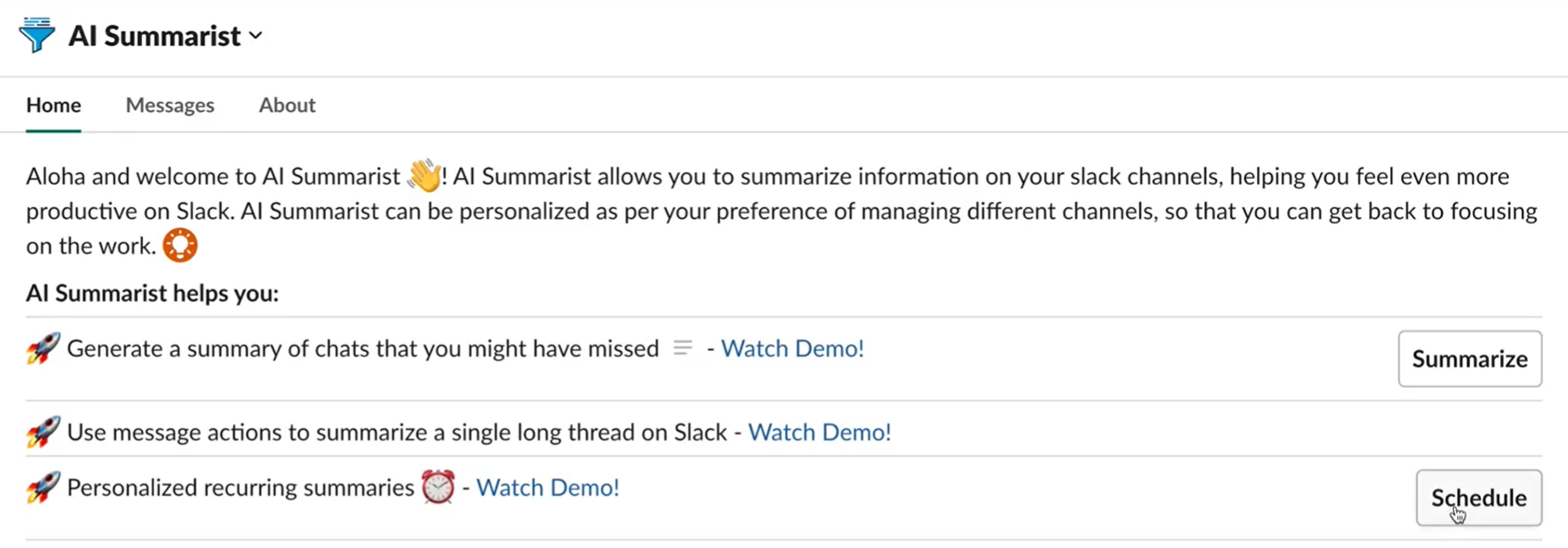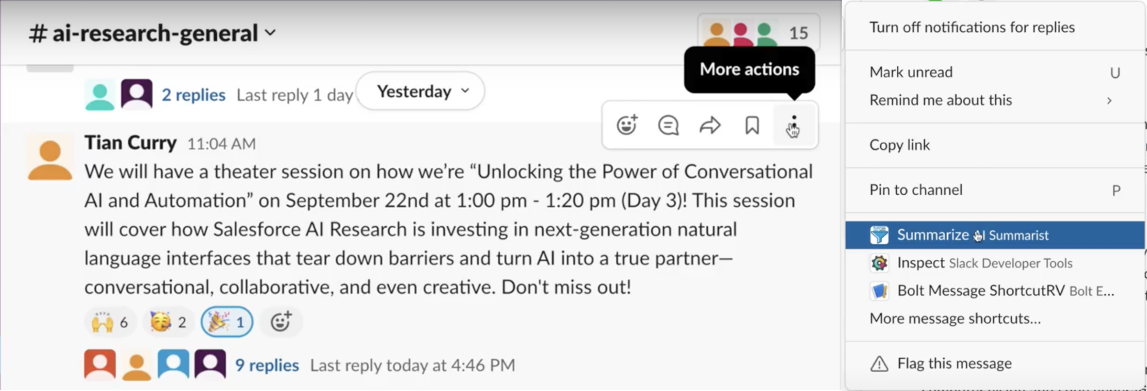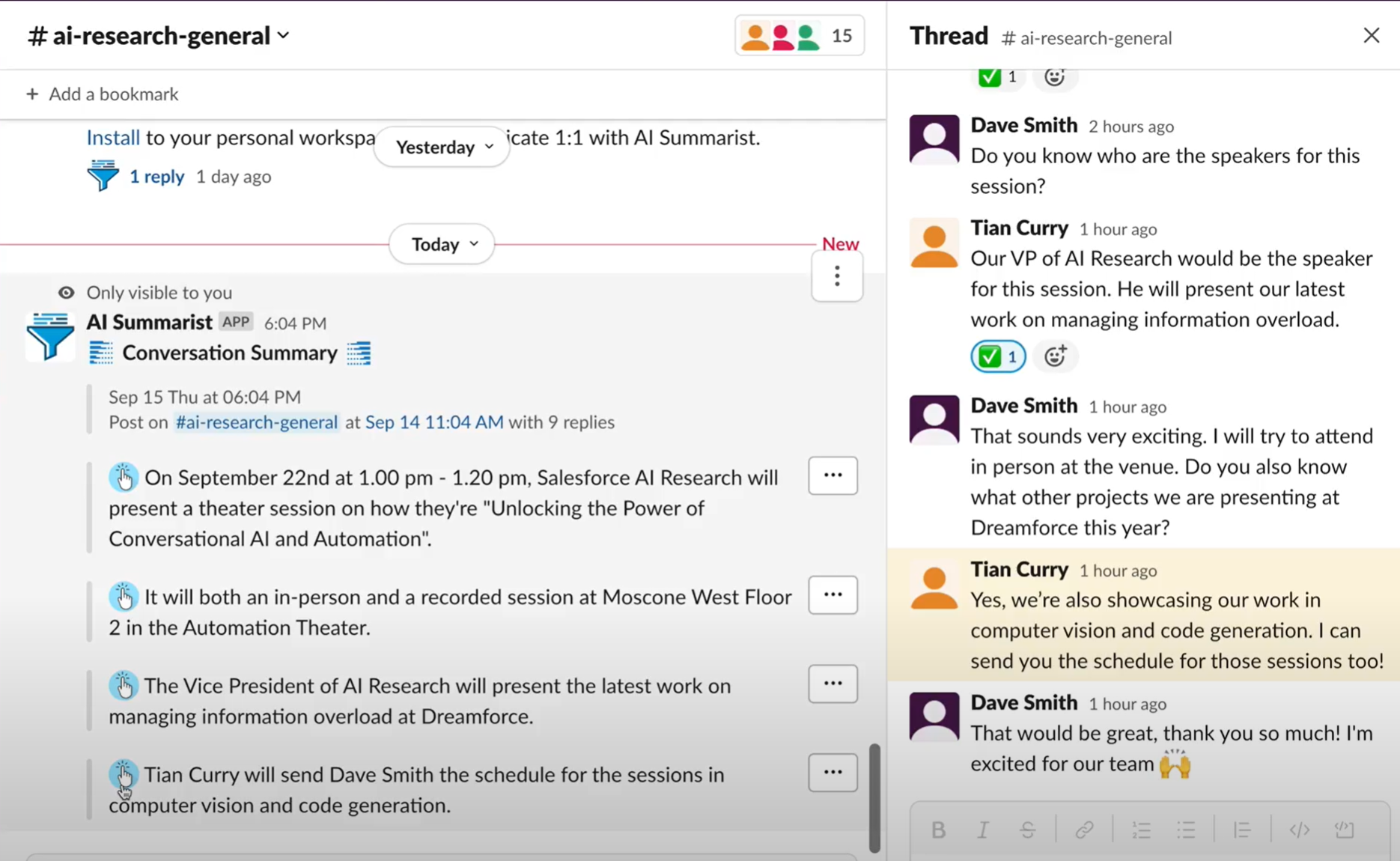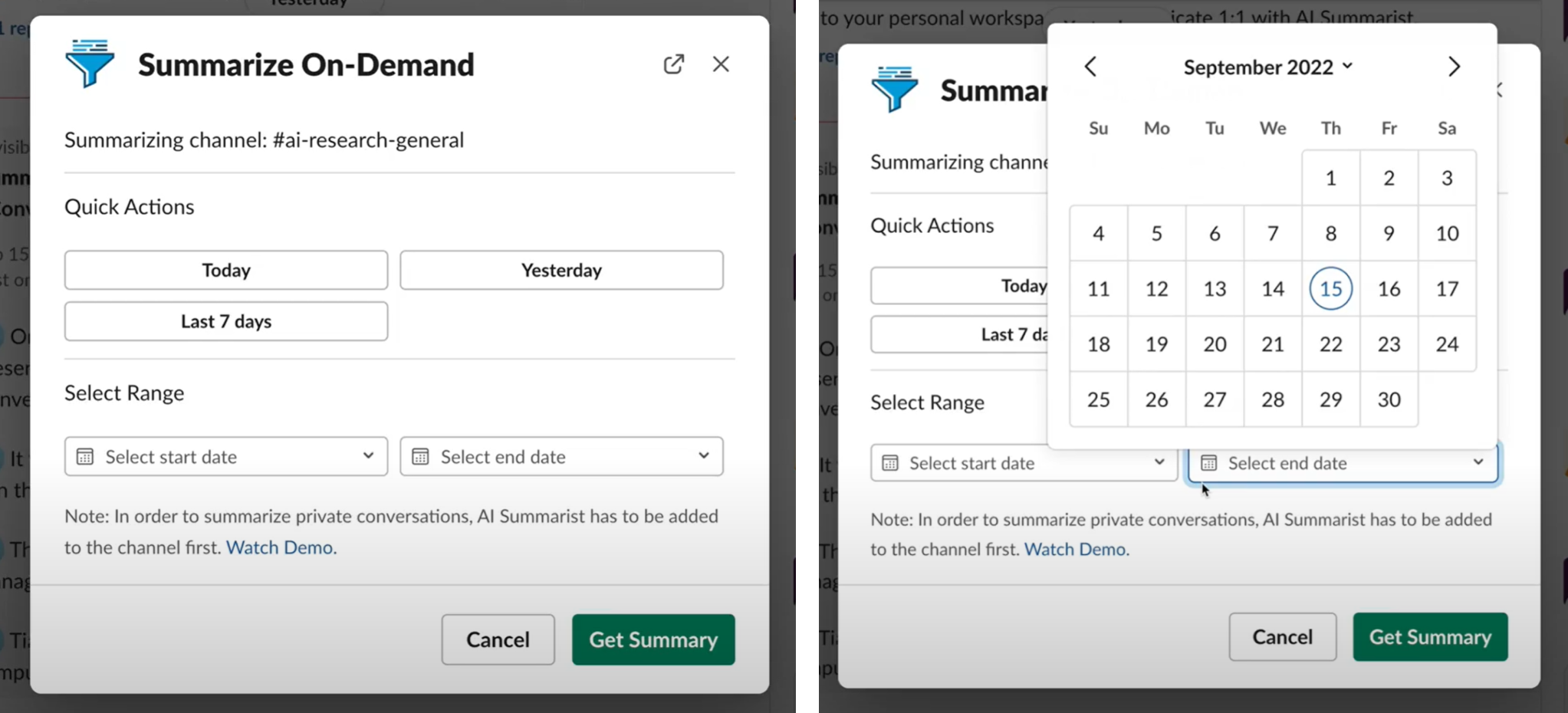AI Summarist: Get Your Time Back on Slack, Boost Productivity & Focus, Personalize Information Consumption
TL;DR: Slack is a powerful productivity tool that professionals and teams around the globe depend on to communicate and keep up with vital information at work, making async work efficient. However, with an increase in the number (and variety) of conversations on Slack that a typical user keeps track of, their information consumption can multiply over time. This may lead to a steady increase in the cognitive load experienced by users, which can feel overwhelming and affect deep work. Enter AI Summarist - a state-of-the-art conversational AI powered tool, which summarizes Slack conversations for you, helping you manage your information consumption as per your work preferences.
Background
Slack has been the de-facto leader in offering a collaborative platform that allows teams to communicate effectively and get work done in a fast, efficient manner. It frees teams from those dreaded “info silos'' (where emails can get hidden, lost, or forgotten, causing projects to bog down). Once Slack becomes your digital HQ, you can rely on it for accessing information, resources and people that are important for you to move your projects forward.
However, popularity can be a double edged sword: with a large number of teams now enjoying Slack, and more joining daily, there are a plethora of channels to read and monitor. One could easily fill the day reading interesting and useful content on Slack channels separate from your work (such as the latest news in tech, social channels for your interests, corporate event updates, volunteer activities, and more), but that could potentially reduce productivity and affect deep work.
So, as good as Slack is, we couldn’t help but wonder: are there ways to use AI to make it even better? Can we provide users an easy way to feel more ‘in control’ of their content on Slack, while reducing the cognitive load? We believe we’ve found such a way.
Our Goal: Give Users Control Over Their Information
The overall goal of this project is to make working with Slack easier and more efficient for all users – and do it in a non-intrusive way, as natural and enjoyable an experience as using Slack itself.
Managing work while being active on multiple Slack channels during the day can typically increase the cognitive load a user experiences. Our specific goal is to reduce this load in a seamless way – to create a “tool-within-a-tool” to better manage all the information steadily streaming into our channels, DMs, and threads.
How do we do that? By using the power of AI, of course!
AI Summarist: Manage Slack Content With Conversational AI
This project uses state-of-the-art conversational AI to help users manage the volume of information on Slack in an efficient manner – to help users efficiently process the steady stream of content updates from multiple channels, DMs, and threads. AI Summarist helps you personalize your information consumption and (indirectly) manage your notifications on your Slack channels, by reading summaries to catch-up on information.
Value and Benefits
Let’s explore why AI Summarist is so valuable, and how you can use it to optimize time you spend on Slack during work:
- Optimize how you read your daily content: Let’s face it: some channels are just more important to you than others, and time is limited. Now you can stay on top of channels that relate to your day-to-day work and get automatic summaries from other channels.
- Personalize your information consumption: Have more control over consuming information from specific channels based on your work preferences. Eg: Want to make sure you don’t miss anything important before you unwind for the weekend? Get a weekly summary of the required channel every Friday at 12pm.
- Explore new (and more) channels: Read summaries of newly discovered or suggested channels that you might be interested in, and use these summary overviews to decide if you want to follow them regularly. You’re more likely to participate in more Slack channels if you have the option to manage information consumption.
- Catch up quickly after time off: If you’ve been away for a few days, catch up on your messages quickly by reading channel summaries with the option to dive deeper (read full content) depending on the relevance or importance.
- Identify the important threads: While summarizing a large number of chats, AI Summarist automatically identifies the most important threads based on the reactions and replies.
- AI Summarist is a particularly significant tool for neurodiverse users on Slack.
How Summarization Works: Steps to a Slack Summary
The summarization process works end-to-end in an ad hoc manner. When a user initiates a summarization request through AI Summarist, the following steps are executed:
- API gets chats: The Slack API is called to collect the chat messages posted during the specified/intended duration
- Disentangling conversations: AI Summarist identifies separate conversations in the collected stream of messages
- AI wields the magic wand: The conversations are passed through an AI model that generates a concise summary
- Summary delivered: The summary is sent privately to the user who initiated the request, tailored based on importance for longer durations
Demo: AI Summarist in Action
Let’s look at the AI Summarist in action.

Conversation Summary
In our first example, we request a summary of a message on our team channel, which has several replies to it.
To get things started, click the three dots that opens the message actions menu.

Then find and click the ‘Summarize’ shortcut provided by AI Summarist from the drop-down menu.
AI Summarist notifies you that your summary is now in progress…
A summary of the conversation is sent to you promptly.

Lines in the summary are linked to the original conversation that was used to create it, so you can always refer back to the original thread if you want to read further and get more context.
Click on any line in summary to read the original message thread summarized in that sentence.

Channel Summary
Now let’s see how AI Summarist summarizes an entire channel for the specified duration.
Just type ‘/summary’ or ‘/summarize’ anywhere in the Slack chat.
The app opens up a dialog box giving you several options to tailor the summary to your needs.
You can give instructions about your desired timeframe for the summary... like Today, Yesterday, or Last 7 Days. Alternatively, you can provide a date range.

A summary of all of yesterday’s conversations, for the entire #ai-research-general channel is sent to the requesting user.

Scheduling Summaries
AI Summarist also gives you the ability to choose when and how often you want to receive summaries. Using this option to receive daily or weekly summaries helps ensure you don’t miss anything important before you unplug at the end of the day, or before you take off for the weekend.
Select the channel you want summaries for, then choose Daily or Weekly.
You can set the day of the week you want your summaries, and what time (for example, every Friday at 9am).

Data Privacy
AI Summarist is careful about handling users’ data and the sensitive nature of information in your Slack messages. To ensure that users feel safe using the tool for their private and sensitive content on Slack, AI Summarist doesn’t store any of the information that it summarizes. Neither the original chats nor the generated summary is saved. All functions are executed in an ad-hoc manner, whenever the user initiates a request.
AI Summarist only stores metadata related to the functions invoked by the users, and allows users to provide essential feedback on the generated summary. This feedback can be used to further understand any shortcomings with respect to the expectations of the users, and improve the dialogue summarization capabilities of AI Summarist. The users are prompted to be careful about keeping the feedback free of PII.
The Bottom Line
Slack is awesome. AI Summarist makes it even better by enabling Slack users to generate summaries of channel content automatically, on demand. Now you can dive deep to read all of some channels, and read summaries of others – the choice is yours when you integrate Slack and AI Summarist.
We look forward to further improving AI Summarist over time, and applying feedback from users’ experiences to ensure that it provides the highest possible value.
Explore More
Salesforce AI Research invites you to dive deeper into the concepts discussed in this blog post (see links below). Connect with us on social media and our website to get regular updates on this and other research projects.
- Get the FAQs: For additional information, please see the FAQ section of our AI Summarist Info page.
- Feedback: You can provide feedback on AI Summarist by reaching out directly to Divyansh Agarwal, Tian Xie, or Jason Wu at Salesforce (emails below)
- Contact us: divyansh.agarwal@salesforce.com , txie@salesforce.com , or wu.jason@salesforce.com
- Follow us on Twitter: @SalesforceResearch, @Salesforce
- Blog: To read other blog posts, go to blog.salesforceairesearch.com
- Main site: To learn more about all of the exciting projects at Salesforce AI Research, please visit our main website at salesforceairesearch.com.
About the Authors
Divyansh Agarwal is a Senior Research Engineer at Salesforce AI Research, and leads the AI Summarist project. His work involves developing and studying large-scale AI applications that allow real-world user interaction with AI models. He is active in Natural Language Processing (NLP) research on topics like summarization, conversational AI, and NLP for search.
Tian Xie is a Research Engineering Manager at Salesforce AI Research. He is leading the applied interactive AI projects. He has been working on building intelligent task-oriented dialogue systems, language models for dialogue applications, and etc.
Jason Wu is a Senior Research Manager at Salesforce AI Research, leading the Interactive AI Team. His research focuses on deep learning and natural language processing, particularly, Conversational AI, Text Summarization, and Human-Computer Interaction. He serves as program committee for various leading conferences such as ACL/EMNLP/NeurIPS/ICLR, and journals such as the IEEE/ACM TASLP, CSL, and TACL. More details are available on his personal website.
